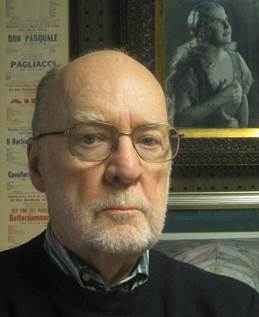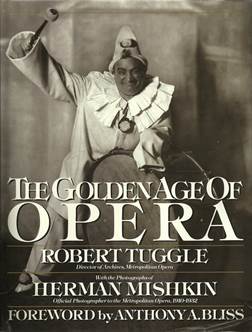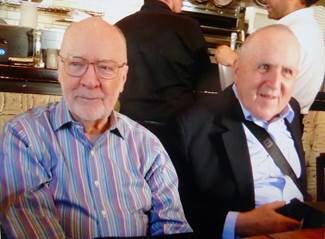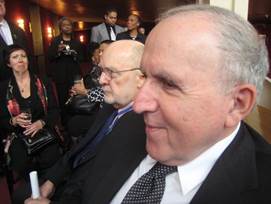 (all photos courtesy Charles Mintzer)
(all photos courtesy Charles Mintzer)ROBERT TUGGLE 17 April 1932 (Martinsville, Virginia)—21 January 2016 (New York City)
A PERSONAL REMEMBRANCE
 (all photos courtesy Charles Mintzer)
(all photos courtesy Charles Mintzer)
Born in Virginia, he achieved his advanced education at Princeton University with a major in musicology; he wrote his thesis on Early Verdi. After two years of US Army service he worked for almost two decades at the Metropolitan Opera Guild as Director of Education, and in 1982 he was appointed the Director of Archives of the Metropolitan Opera succeeding the late Mary Ellis Peltz, founder of the Archives. While at the Guild he continued the tradition started in the 1930s of student performances; he was particularly proud of the 11 April 1966 student performance of “Fanciulla del West” given before the official “Anthony and Cleopatra” opening on 18 September; this performance was presented in order to test the acoustics and the reverberation factor of the new theater with a full audience present.
I first met Bob in 1978 and ever since then there has been barely a day that we have not spoken with each other. I was introduced to Bob through the suggestion of the late American opera performance historian, Charles Jahant, that he just might have photo resources to offer me in my ongoing project, the biography of Rosa Raisa. Bob was in the early stages of writing his great book, “The Golden Age of Opera” based on the photos of the Manhattan Opera and Metropolitan Opera photographer Herman Mishkin. He realized early on that I too had done significant research in the Mishkin period, 1906-1932. We discussed who should be included in the book and shared research and anecdotes about the great singers of that period. When the book was published in 1983 Bob gave me a prominent, beautiful and generous acknowledgement for the help I gave him. He made a special trip to Brooklyn to give me my copy of the book with an acknowledgement of “our” book. Through Bob I learned much about opera photography and with his encouragement I started to systematically develop my own opera photo/autograph collection that eventually became my primary collecting passion and the collection grew into a major achievement.

But our comradeship did not end with the Mishkin book. Our friendship took many turns as we shared personal, family, health and other issues with each other. I spent birthdays, Thanksgiving and Christmas at Bob’s home on the Upper West Side of Manhattan with his partner Paul Jeromack, an apartment superbly furnished and decorated with outstanding examples of the American, English and French Aesthetic Movements, of which Bob was an expert.
When I retired from government service in 1990, Bob at first gently suggested that I join the staff of the Met Archives as a volunteer. For twenty-five years now, every Wednesday I would meet Bob in the Met cafeteria for breakfast, and at noon for lunch. I met so many Met artists and employees who would stop at our table to discuss work and gossip. I would often ask after some of these people continued on their way, “Who is that?” and I learned a lot about the company’s internal issues. Bob trusted me to be very careful in never breaking confidences over what I learned in these encounters. As a volunteer I had become a member of the Met family. My weekly work on the Met database gave my life an important structure. For a retiree, there is no greater gift than a chance to participate in something one loves. The prize-winning Met database was Bob’s baby and I was happy to participate in its ongoing enlargement. At the time of his death I had worked on finding and scanning/typing reviews appended to 3,679 performances, with many performances having multiple reviews and viewpoints. For example, the 1908 opening night which featured the start of the Gatti-Casazza regime, the debuts of Arturo Toscanini and Emmy Destinn has fourteen reviews supplemented by rare Caruso caricatures of the artists and photos of the then remarkable scenery. Bob and I worked over a month to create this special chapter.
Click here for an interview with Tuggle at archives
Click here to visit 'his' Met database
The Met database was the incredible achievement of Bob and his staff. No other opera company, to my knowledge, has been able to develop anything comparable. At the time of Bob’s death he was working on the new edition of the database, which is to have more more capacity for additional sound and photo materials, while retaining its speed, “easy to use” and interactive features. The new database is necessary as the company that developed and supported the current edition no longer supports it. A new company had to be found that would meet Bob’s exacting standards. This process and the obtaining of funding took a long time.

(Tuggle at Charles's birthday party on September 6, 2015)
In addition to the Mishkin photo book described, Bob’s next project was to be the definitive biography of Kirsten Flagstad, a singer he more than admired and whom he heard in person in 1951 (“Tristan” and “Fidelio”), 1952 (“Alceste”) and 1955 (Symphony of the Air concert, twice). One of the reasons the book was not ready at the time of his death may have had something to do with a remark I made to him in about 1998, that in order to have the last word on the more controversial elements of her life he “had to get it right.” This pursuit of the truth led him to several trips to Norway, amassing everything that was said about her, interviewing most people who still had first hand knowledge of her including court transcripts and financial data. From the preliminary chapters he penned and shared with me I can state that there would be nothing even remotely comparable or more thoroughly researched and documented in the genre of opera singer biographies. Hopefully it will be published some day.

Tuggle being recognized for 50 years service to the Met. Charles was his guest)
Bob had a lot of opinions about the singers he heard in person and the ones he admired on vintage recordings. After Flagstad I think the singer he most admired was Maria Callas. While in the US Army, stationed at Fort Knox, Kentucky he took leave and went to Chicago 1 November, 1954 for Callas’ US debut in “Norma.” He also heard the following season the 3 November, 1955 “dream” “Il Trovatore” with Callas, Stignani, Bjoerling (his favorite tenor) and Bastianini. He maintained that it was easily Stignani’s night for the greatest and most opulent singing. He maintained that Callas, Simionato and Gobbi sounded more significant in the Chicago Civic Opera House than at the Met.
I believe it was in 2000 that Bob underwent a double bypass for his heart. He was very stable until a few years ago when collateral issues developed. In fact it was Wednesday morning, 20 January, at breakfast that I mentioned that my own health issues were of concern, especially shortness of breath. He said he had not been feeling right for some time and also had shortness of breath and that he had made an appointment with his cardiologist for later in the morning. That was the last time I saw Bob. He did not return for our lunch, but notified me that he was being hospitalized for observation and tests for endocarditis. Late Thursday afternoon I heard that Bob passed away from a massive stroke that occurred in the hospital while being tested.
Charles Mintzer, January 2016